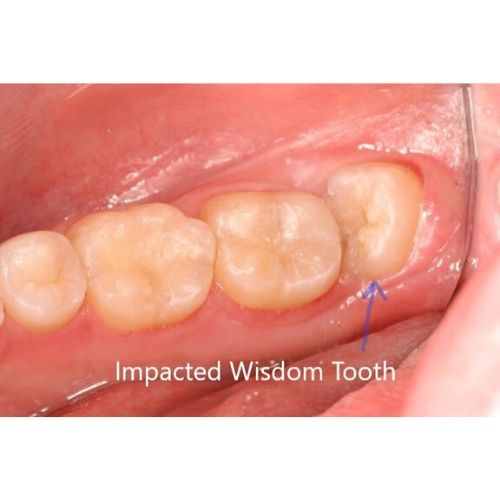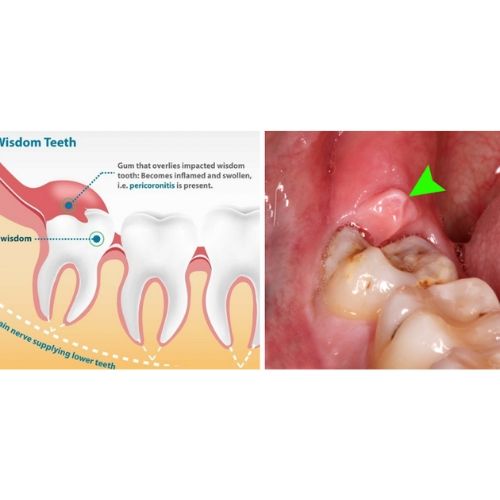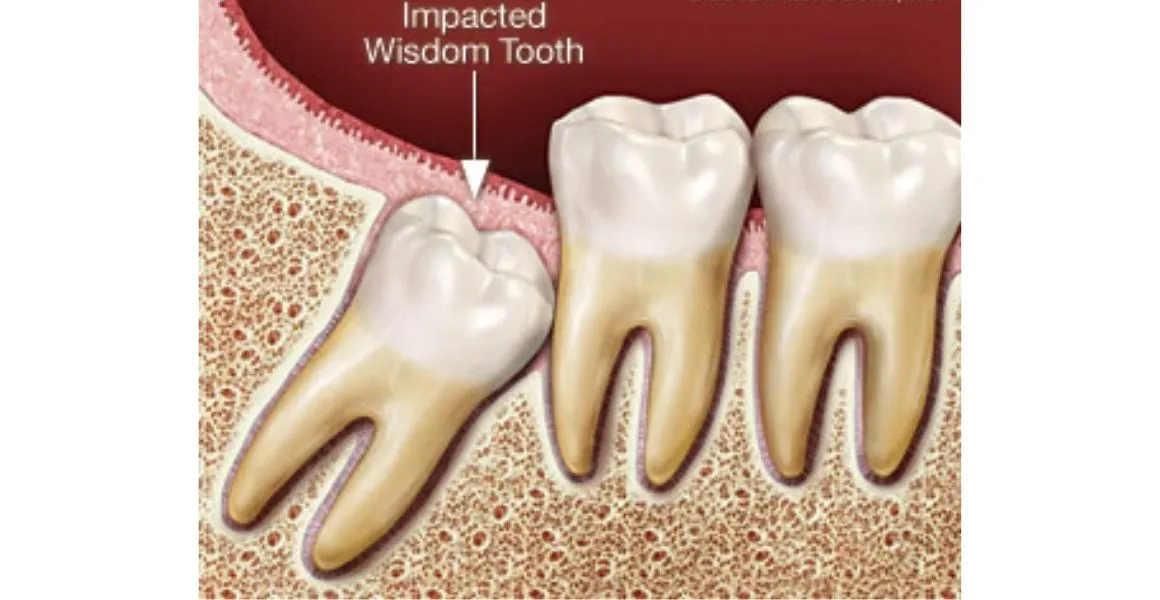Wisdom Tooth Extraction and Removal
Wisdom teeth are also known as the 3rd molar. It is usually the last tooth to erupt or come in the mouth. It usually erupts between the age of 18 to 30. However, it may erupt at later years in life also.
Wisdom teeth have an uncanny knack of coming out in the wrong direction and place and hence often causing problems or pain. (FIG: 1)

There are a total of 4 wisdom teeth in each person, two in each jaw (upper jaw 2 – left and right, lower jaw 2 – left and right). (FIG: 2)

The upper teeth usually come out more in an outward or buccal direction and backwards too, whereas the lower teeth have a tendency to erupt in a forwardly angulated direction. (FIG: 3)

At most times the wisdom teeth are not able to completely come out in the mouth in their normal position and are blocked. This is known as wisdom tooth impaction or impacted wisdom tooth. (FIG:4)

Removal of an impacted wisdom tooth requires a minor surgical procedure. Fully erupted impacted tooth can be removed like any other tooth in the mouth, however with some extra effort and time.
Do I need to remove my wisdom tooth?
A detailed consultation with your dentist followed by a panoramic X-ray will let you know whether wisdom tooth removal is the best option for you.
The 1st and foremost we take a small Intraoral X-ray and advice you an extra-oral X-ray (Digital OPG). (FIG:5 )


In the X-ray, we can study the position of the wisdom tooth and its relation to the surrounding structures (Other teeth, nerves and bone).
We evaluate your signs and symptoms and compare them to your X-ray, and then take a call if wisdom tooth removal is the best treatment option for you. (FIG: 6 )

The following points are considered when making a decision-
Whether it is decayed or infected – if yes then it is best to remove ASAP. (FIG: 7 )

Whether the surrounding gums are inflamed or infected. – If yes then it’s better to remove especially if problem or pain in the gums is reoccurring. However, sometimes simple gum cutting may also be helpful.
If the Tooth is in an unfavourable position where it is difficult to keep it clean it is best to remove it in the long run as it is bound to decay further and cause severe pain and swelling.
If it has led to a reduction in mouth opening and or swelling it also advisable to get removed as the condition is only going to become worse with time.
Sometimes the tooth and the overlying gums or cheek may become extremely painful especially on chewing and biting, in such conditions the dentist will take a call what is the best treatment option depending on the severity and other factors. (FIG: 8 )

What if I don’t remove (don’t want to remove) my wisdom tooth?
Temporary relief may be provided by taking painkillers antibiotics and mouthwash, but that is all palliative treatment. It will be effective only if the pain and swelling are minimal. In most instances, the trouble will return once you stop the medications or in a few days time, with greater vigour and valour. Eventually requiring removal of the wisdom teeth.
Also delaying treatment for a longer period of time can result in one or all of the following
Wisdom teeth apply pressure on the remaining teeth and hence can result in crowding or crooked movement of the front lower teeth. (FIG: 9)

It may decay further leading to pus formation and extraoral ( face swelling)
It may also lead to cyst formation in some cases.
The teeth can break down and further complicate the treatment.
It can also cause the adjacent teeth to decay and have a cavity. (FIG: 10)

How is the Procedure (removal of wisdom teeth) done?
- Pre-Procedure Medications are generally started to bring the pain and swelling if any under control. Anti-biotics are usually started a day prior to or from the day of treatment.
- At World Smiles Dental Centre your wisdom teeth removal is done by an experienced oral surgeon.
- An oral Surgeon is a person who specialises in the removal of all teeth especially the wisdom teeth. We have a team of world-class oral surgeons which makes sure your treatment is done by the best professionals with minimal or no discomfort/pain, also ensuring a smoother recovery.
- The Entire procedure is usually completed under half an hour. Topical anaesthesia is first applied to numb the skin of the mouth before injecting local anaesthesia.
- The topical anaesthesia makes the prick almost painless.
- Once the area is totally numb does the surgeon begin the procedure?
- In most instances, a cut is given on the gums to expose the tooth. If the tooth is deep inside the bone, a certain amount of bone cutting may also be required.
- The tooth is slowly teased out with the help of special instruments. It may be sectioned and removed if its position isn’t favourable.
- Since your constantly under anaesthesia and being worked upon by an experienced surgeon the entire process is almost painless. You might only feel some pressure will remove the tooth.
- Once the tooth is out the entire area is nicely cleaned and irrigated and stitches are placed. The stitches are placed to ensure faster wound healing and recovery. They are removed after 7-10 days time.
Post Treatment care after removal of wisdom tooth.
When the anaesthesia wears off, there may be little jaw stiffness, difficulty in opening the mouth and some pain or discomfort. However, with medications, it will be under control and bearable. The anaesthesia effect may last for about 2-3 hours post-treatment.
- The dentist will ask you to bite onto a cotton Gauze piece for about half an hour to help the blood clot form. It’s important to protect this clot as the wound heals.
- After 1 Hour you can have something chilled like ice cream or smoothie. Eating food should be avoided until the anaesthesia effect wears off.
- For a day you need to swallow all the blood and saliva which comes in your mouth. This is important so that clot formation isn’t disturbed. It is absolutely alright to swallow your own blood and saliva. It’s a part of you and your body.
- Eat soft foods, and don’t smoke, use a straw or spit, as these actions can dislodge the clot.
- Don’t smoke on the day of surgery, as it can increase the chance of dry socket, a painful condition that occurs when a blood clot doesn’t form in the hole, breaks off, or breaks down too early. (FIG: 11 )

FIG: 11, Dry Socket - You can apply ice externally from outside the mouth in the region of the tooth removal.
- You need to avoid eating anything Hot, Hard and Spicy for 3-4 days.
- Diet needs to soft which requires minimal chewing like smoothies, yoghurt, shakes, pudding, soups, pureed foods etc.
- Avoid spicy foods, nuts, popcorn, smoking, tobacco etc.
- You need to start with warm saline gargles 3-4 times a day from the next day. (1/2 teaspoon of salt mixed with 1 glass of warm water.)
- You can brush your teeth from the next day, you only need to be a little gentle in the region where we have removed your teeth.
- Keep the area as clean and infection-free as possible.
- Take your medications on time.
- Avoid Alcohol while under medications.
- If you get severe pain or swelling kindly report to us immediately.
- It generally takes about 10 to 14 days for the wound to cover up.
- You need to visit after a weeks time to get the stitches removed and the extraction site evaluated.

